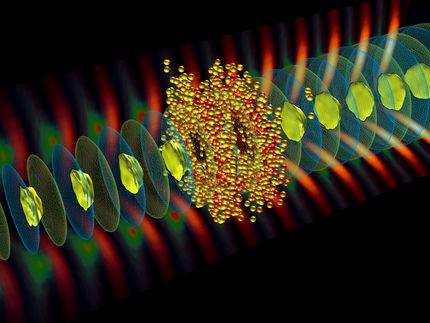Antimatter catches a wave at SLAC
(DOE/SLAC National Accelerator Laboratory) A study led by researchers from the US Department of Energy's SLAC National Accelerator Laboratory and the University of California, Los Angeles has d
A study led by researchers from the U.S. Department of Energy's (DOE) SLAC National Accelerator Laboratory and the University of California, Los Angeles has demonstrated a new, efficient way to accelerate positrons, the antimatter opposites of electrons. The method may help boost the energy and shrink the size of future linear particle.

F. Tsung/W. An/UCLA/SLAC National Accelerator Laboratory
The scientists had previously shown that boosting the energy of charged particles by having them "surf" a wave of ionized gas, or plasma, works well for electrons. While this method by itself could lead to smaller accelerators, electrons are only half the equation for future colliders. Now the researchers have hit another milestone by applying the technique to positrons at SLAC's Facility for Advanced Accelerator Experimental Tests (FACET).
"Together with our previous achievement, the new study is a very important step toward making smaller, less expensive next-generation electron-positron colliders," said SLAC's Mark Hogan. "FACET is the only place in the world where we can accelerate positrons and electrons with this method."
Shrinking Particle Colliders
Researchers study matter's fundamental components and the forces between them by smashing highly energetic particle beams into one another. Collisions between electrons and positrons are especially appealing, because unlike the protons being collided at CERN's Large Hadron Collider these particles aren't made of smaller constituent parts.
"These collisions are simpler and easier to study," said SLAC's Michael Peskin, a theoretical physicist not involved in the study. "Also, new, exotic particles would be produced at roughly the same rate as known particles; at the LHC they are a billion times more rare."
Previous work showed that the method works efficiently for electrons: When one of FACET's tightly focused bundles of electrons enters an ionized gas, it creates a plasma "wake" that researchers use to accelerate a trailing second electron bunch.
Creating a Plasma Wake for Antimatter
For positrons - the other required particle ingredient for electron-positron colliders - plasma wakefield acceleration is much more challenging. In fact, many scientists believed that no matter where a trailing positron bunch was placed in a wake, it would lose its compact, focused shape or even slow down.
"Our key breakthrough was to find a new regime that lets us accelerate positrons in plasmas efficiently," said study co-author Chandrashekhar Joshi from UCLA.
Instead of using two separate particle bunches - one to create a wake and the other to surf it - the team discovered that a single positron bunch can interact with the plasma in such a way that the front of it generates a wake that both accelerates and focuses its trailing end. This occurs after the positrons have traveled about four inches through the plasma.
"In this stable state, about 1 billion positrons gained 5 billion electronvolts of energy over a short distance of only 1.3 meters," said former SLAC researcher Sébastien Corde, the study's first author, who is now at the Ecole Polytechnique in France. "They also did so very efficiently and uniformly, resulting in an accelerated bunch with a well-defined energy."
Original publication
S. Corde, E. Adli, J. M. Allen, W. An, C. I. Clarke, C. E. Clayton, J. P. Delahaye, J. Frederico, S. Gessner, S. Z. Green, M. J. Hogan, C. Joshi, N. Lipkowitz, M. Litos, W. Lu, K. A. Marsh, W. B. Mori, M. Schmeltz, N. Vafaei-Najafabadi, D. Walz, V. Yakimenko & G. Yocky; "Multi-gigaelectronvolt acceleration of positrons in a self-loaded plasma wakefield"; Nature; 2015
Most read news
Original publication
S. Corde, E. Adli, J. M. Allen, W. An, C. I. Clarke, C. E. Clayton, J. P. Delahaye, J. Frederico, S. Gessner, S. Z. Green, M. J. Hogan, C. Joshi, N. Lipkowitz, M. Litos, W. Lu, K. A. Marsh, W. B. Mori, M. Schmeltz, N. Vafaei-Najafabadi, D. Walz, V. Yakimenko & G. Yocky; "Multi-gigaelectronvolt acceleration of positrons in a self-loaded plasma wakefield"; Nature; 2015
Organizations
Other news from the department science

Get the chemical industry in your inbox
By submitting this form you agree that LUMITOS AG will send you the newsletter(s) selected above by email. Your data will not be passed on to third parties. Your data will be stored and processed in accordance with our data protection regulations. LUMITOS may contact you by email for the purpose of advertising or market and opinion surveys. You can revoke your consent at any time without giving reasons to LUMITOS AG, Ernst-Augustin-Str. 2, 12489 Berlin, Germany or by e-mail at revoke@lumitos.com with effect for the future. In addition, each email contains a link to unsubscribe from the corresponding newsletter.


























































